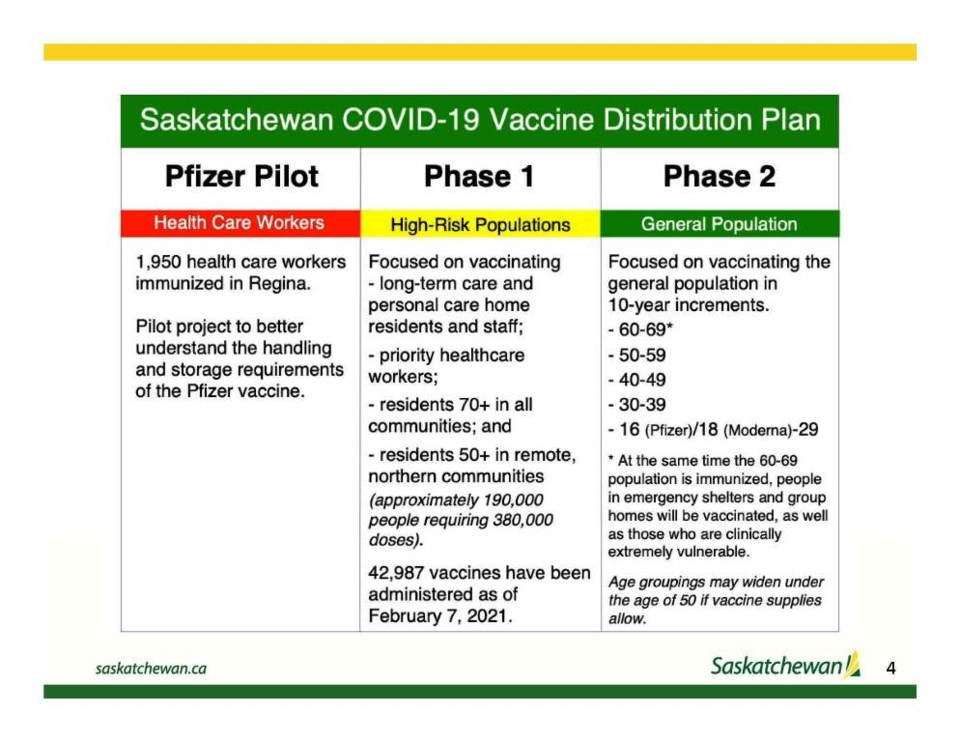The Ministry of Health and Saskatchewan Health Authority (SHA) have made it relatively simple in determining who is next in line for the COVID-19 vaccines in Phase 2 of the vaccination program. Except in very few exceptional cases, the older you are, the sooner you will get the vaccine.
That’s according to Minister of Health Paul Merriman and SHA CEO Scott Livingstone during the Feb. 9 COVID-19 briefing, held at the Legislature in Regina.
Merriman said, “We are currently still in Phase 1, which covers priority health care workers, residents and long-term care staff, and other Saskatchewan residents over the age of 70. Phase 2 will be our mass vaccination stage. It’s going to begin hopefully sometime in April, depending on the number of doses that we receive in the coming weeks from the federal government. Our goal will be to vaccinate as many people as possible, as quickly as possible, and to do so in a way that reduces severe outcomes as much as possible.
“For that reason, we will be focusing on age as the primary risk factor. We know that age is the number one factor in determining severe outcomes from COVID-19. So our mass vaccination will be done by age, starting with our oldest residents first. Right now, we’re in Phase 1, which includes everyone over the age of 70. In Phase 2, we will be vaccinating people over 60, then people over 50, and so on, until everybody that wants to be vaccinated can be.”
Merriman continued, “There’ll be a few additional groups prioritized like clinically extremely vulnerable individuals, and people in some congregate living settings like emergency shelters and group homes. But like most other provinces, we are organizing our mass vaccination program, primarily on age, because that’s the best way to get things done for the most people, the quickest. And that’s the best way to reduce severe outcomes.”
The pair expressed almost palpable exasperation with the low numbers of vaccine doses coming from the federal government. Merriman noted, “This week, we expect to receive fewer than 2,000 doses here in Saskatchewan. To date, we have received 45,000 doses. There are about 190,000 people in our Phase 1. And as a two-dose vaccine, That’s 380,000 shots. That means, so far, we have only been able to do 12 per cent of the people identified in Phase 1.
“The federal government has assured us that vaccine shipments are going to start picking up next week, and we will continue to increase up to March in the second quarter of this year. But it could be sometime in April, before we get to Phase 2. But Saskatchewan is ready for this. We just need some more vaccines, and they can’t get here soon enough.”
Livingstone explained, “We’re nowhere near our target goal in Phase 1 and that is primarily, almost exclusively due to the fact that we haven’t received vaccine to deliver. And that will continue to be a challenge for us without knowing what vaccine is coming past quarter one of this year.”
Those at high risk, beyond the issue of age, will be targeted first in Phase 2. The province has put together a list including those who live in select congregate living settings like group homes for persons with intellectual disabilities and emergency shelters.
People with underlying health conditions that are clinically extremely vulnerable include:
• Solid organ transplant recipients.
• People with specific cancers.
• People with severe respiratory conditions.
• People with rare diseases that significantly increase the risk of infections.
• People on immunosuppression therapies sufficient to significantly increase
the risk of infection.
• Adults with very significant developmental disabilities that increase risk.
• Adults on dialysis or with chronic kidney disease.
The province will be setting up over 226 clinics in 181 communities, including numerous drive-through, mobile and mass clinics. On top of that, pharmacies across the province will also take part. Livingstone noted that for the last round of influenza shots, 385 pharmacies in 113 communities took part, accounting for about half of the total vaccinations done for the flu last year.
As for immunization records – those immunized will be given a paper card. There will also be an electronic record accessible through MySaskHealthRecord at ehealthsask.ca
People covered in Phase 1 like long-term care and personal care home residents will be contacted directly. Priority health care workers will be contacted to book an appointment. People over the age of 70 who live independently will receive information through direct contact, wherever possible, through local media or social media.
Livingstone noted that if someone choses to not get the vaccine when their group is called up, you can still choose to get it done later.
For Phase 2, there will be a central scheduling system online through www.saskatchewan.ca or a toll free number, both of which will be operational in March.
Merriman said “I’ve heard from a lot of people they want to know what’s going on. What is it going to look like? how are we going to be informed? And when can we get in?
“So we’re trying to give them two of the three of that. What is it going to look like with the mass vaccination clinics, the drive throughs and also the mobile clinics. We’re going to tell them how that they can do this. The when is a little bit out of our hands right now. It’s not a little bit; it’s completely out of our hands. That’s when the vaccination or the vaccines actually start flowing will determine the when.”




